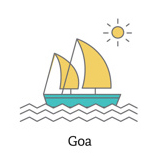 Discover Goa - Culture, Food, Attractions and Key Facts
Discover Goa - Culture, Food, Attractions and Key FactsCapital - Panaji
No. of Districts - 2
Population - 1,458,545
Area - 3,702 sqkm
Pop. Density - 394/km2 (1,020/sq mi)
GDP - 0.772 lakh crore (US$11 billion)
Literacy Rate - 88.7%
Gender Ratio - 973
Official Website - https://www.goa.gov.in/
Goa is a state located on the western coast of India, known for its picturesque beaches, vibrant nightlife, rich history, and diverse cultural heritage. Here are some key facts about Goa:
Location: Goa is situated on the western coast of India, bounded by the Arabian Sea to the west and the Western Ghats to the east.
Capital: Panaji (also known as Panjim) is the capital city of Goa.
Language: Konkani is the official language of Goa. However, English, Hindi, and Marathi are also widely spoken.
History: Goa was a Portuguese colony for over 450 years until it was annexed by India in 1961. This colonial history has left a lasting influence on Goan culture, architecture, and cuisine.
Tourism: Tourism is a major industry in Goa, attracting millions of domestic and international tourists every year. The state is famous for its pristine beaches, such as Calangute, Baga, Anjuna, and Palolem, as well as its vibrant nightlife and water sports activities.
Culture: Goa has a unique blend of Indian and Portuguese cultures. This is reflected in its architecture, festivals, music, dance, and cuisine. The state celebrates various festivals, including Carnival, Christmas, Diwali, and Shigmo (a Hindu festival).
Cuisine: Goan cuisine is renowned for its delicious seafood dishes, influenced by Portuguese, Konkani, and Saraswat culinary traditions. Some popular dishes include vindaloo, xacuti, cafreal, and fish curry rice.
Religion: The majority of the population in Goa is Hindu, followed by Christians and Muslims. The state is home to numerous churches, temples, mosques, and other religious sites.
Economy: Besides tourism, other significant industries in Goa include agriculture, mining, manufacturing, and information technology. The state is also known for its robust coconut and cashew industries.
Wildlife: Goa is home to several wildlife sanctuaries and national parks, including Bhagwan Mahavir Wildlife Sanctuary, Mollem National Park, and Cotigao Wildlife Sanctuary. These areas are rich in biodiversity, housing various species of flora and fauna.
Transportation: Transportation in Goa primarily relies on roadways, with a well-developed network of buses, taxis, and rental vehicles. Dabolim Airport serves as the state's main airport, connecting it to major cities in India and abroad.
Education: Goa has a relatively high literacy rate compared to the national average. It is home to several educational institutions, including Goa University, Indian Institute of Technology (IIT) Goa, National Institute of Technology (NIT) Goa, and many colleges offering a range of courses.
These key facts provide an overview of the geographical, historical, cultural, and economic aspects of Goa, highlighting its significance as a popular tourist destination and a vibrant cultural hub in India.